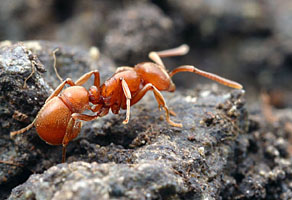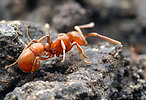Proceratiinae



This tree diagram shows the relationships between several groups of organisms.
The root of the current tree connects the organisms featured in this tree to their containing group and the rest of the Tree of Life. The basal branching point in the tree represents the ancestor of the other groups in the tree. This ancestor diversified over time into several descendent subgroups, which are represented as internal nodes and terminal taxa to the right.

You can click on the root to travel down the Tree of Life all the way to the root of all Life, and you can click on the names of descendent subgroups to travel up the Tree of Life all the way to individual species.
For more information on ToL tree formatting, please see Interpreting the Tree or Classification. To learn more about phylogenetic trees, please visit our Phylogenetic Biology pages.
close boxCharacteristics
The Proceratiinae are characterized by the following apomorphy (Bolton 2003):- Antennal sockets mostly to entirely exposed, close to anterior margin of head
References
Bolton, B. 1994. Identification Guide to the Ant Genera of the World. Cambridge, MA: Harvard University Press.
Bolton, B. 1995. A New General Catalogue of the Ants of the World. Cambridge, MA: Harvard University Press.
Bolton, B. 2003. Synopsis and Classification of Formicidae. 370 pp. Memoirs of the American Entomological Institute, Vol. 71. Gainesville, FL.
Brown, W. L., Jr. 1958. Contributions toward a reclassification of the Formicidae. 2. Tribe Ectatommini. Bulletin of the Museum of Comparative Zoology at Harvard College 118: 175-362.
De Andrade, M. L., and C. Baroni Urbani. 2003. The Baltic amber ant genus Bradoponera (Hymenoptera: Formicidae), with description of two new species and reassessment of the Proceratiini genera. Revue Suisse de Zoologie 110 (4): 913-938.
Hölldobler, B. and E. O. Wilson. 1990. The Ants. Cambridge, MA: Harvard University Press.
Kugler, C. 1991. Stings of ants of the tribe Ectatommini. Insecta Mundi 5: 153-166.
Lattke, J. E. 1994. Phylogenetic relationships and classification of ectatommine ants. Entomologica Scandinavica 25: 105-119.
Wheeler, G. C. & Wheeler, J. 1976. Ant larvae: review and synthesis. Memoirs of the Entomological Society of Washington 74: 1-108.
Title Illustrations

| Scientific Name | Proceratium californicum |
|---|---|
| Location | U.S.A. (California) |
| Sex | Female |
| Life Cycle Stage | Worker |
| Copyright |
© 2004 Alex Wild

|
About This Page
Page copyright © 2004
 Page: Tree of Life
Proceratiinae.
The TEXT of this page is licensed under the
Creative Commons Attribution-NonCommercial License - Version 3.0. Note that images and other media
featured on this page are each governed by their own license, and they may or may not be available
for reuse. Click on an image or a media link to access the media data window, which provides the
relevant licensing information. For the general terms and conditions of ToL material reuse and
redistribution, please see the Tree of Life Copyright
Policies.
Page: Tree of Life
Proceratiinae.
The TEXT of this page is licensed under the
Creative Commons Attribution-NonCommercial License - Version 3.0. Note that images and other media
featured on this page are each governed by their own license, and they may or may not be available
for reuse. Click on an image or a media link to access the media data window, which provides the
relevant licensing information. For the general terms and conditions of ToL material reuse and
redistribution, please see the Tree of Life Copyright
Policies.
- First online 20 March 2004
Citing this page:
Tree of Life Web Project. 2004. Proceratiinae. Version 20 March 2004 (temporary). http://tolweb.org/Proceratiinae/22219/2004.03.20 in The Tree of Life Web Project, http://tolweb.org/







 Go to quick links
Go to quick search
Go to navigation for this section of the ToL site
Go to detailed links for the ToL site
Go to quick links
Go to quick search
Go to navigation for this section of the ToL site
Go to detailed links for the ToL site